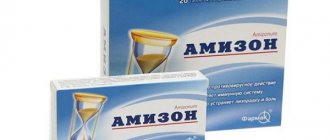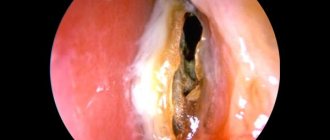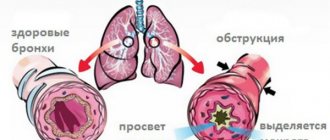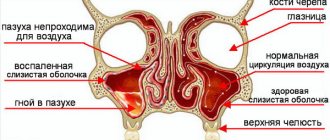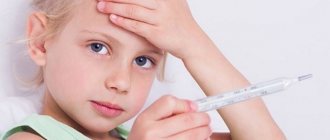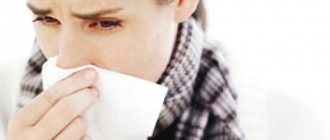Rhinitis in children: causes, types, symptoms and methods of treating the disease
Skip to content
- about the author
- Patient reviews
- Contacts
Home » Diseases » Otorhinolaryngology and pulmonology
Category: Otorhinolaryngology and PulmonologyAuthor: Anna Frank
Rhinitis is the most common upper respiratory tract disease among preschool and school-age children. The consequence of rhinitis is nasal congestion, that is, breathing problems. Frequent incidence of illness interferes with the harmonious, healthy development of the child, reduces his activity, and worsens his performance at school.
Rhinitis in children contributes to a number of complications. In this regard, it is necessary to take timely measures for treatment.
Symptoms of acute rhinitis
The acute form of the disease is manifested by the following symptoms:
- elevated temperature;
- general malaise;
- chills;
- headache;
- sore throat and cough;
- impaired sense of smell;
- changes in taste sensations;
- increased secretion of mucus from the nose.
Acute rhinitis in children is often accompanied by increased tearfulness. Children may also experience temporary loss of hearing sensitivity.
Rhinitis in infants is due to the fact that at this age the nasal passages are still too narrow, and the mucus that forms makes breathing difficult, not having a free exit to the outside. There is no need to treat such rhinitis. Parents should ease their baby's breathing in accessible ways.
Types of disease
Doctors list several main types of rhinitis.
Vasomotor rhinitis
Vasomotor - can occur after the use of medications or through exposure to external irritants, odors, gases. But under no circumstances should it be confused with allergic rhinitis. Accompanied by severe headaches, sneezing, and runny nose. It becomes difficult for the child to breathe through his nose, and tearing increases.
Artrophic
Artrophic rhinitis - occurs in cases of frequent use of nasal drops that constrict blood vessels. The mucous membrane of the tract is depleted, not receiving proper nutrition. Crusts form on the walls, giving off a very unpleasant odor. The child feels constant dryness in the nose, which leads to slight bleeding when blowing his nose. This type of disease can lead to nasal deformation.
Infectious
Infectious rhinitis is one of the most common types of rhinitis in children. Kindergartens and schools, and other public places are hotbeds of accumulation of a huge number of microbes and viruses. Especially during the cold season or during the off-season. Body temperature usually rises to 38 degrees. Even after reduction, a slight runny nose may remain for up to several weeks. Infectious rhinitis occurs both in the initial stages of the development of viral diseases and accompanies them until complete recovery. Sometimes it happens as a consequence of an infectious disease. If treated incorrectly, it can progress to the stage of a chronic disease, and it is much more difficult to cure.
Allergic rhinitis
Allergic rhinitis is divided into two categories: seasonal and year-round.
- Seasonal rhinitis is caused in most cases by an allergy to pollen from plants during their flowering period. Accompanied by frequent repeated sneezing, profuse nasal discharge, headaches and weakness. Children during this period become more irritable and susceptible to other diseases.
- Year-round rhinitis gets its name because the child experiences all of the above symptoms for at least 9 months a year. The list of allergens, in this case, is endless. Pet hair, dust indoors and outdoors, fungi and mold in the apartment, detergents, feather pillows, etc. Today, the allergic type of disease is in no way inferior to the infectious one.
Important! Parents often confuse the symptoms due to their similarity. If in doubt, consult a specialist for an accurate diagnosis.
Symptoms of chronic rhinitis
The chronic form of the disease has distinctive features. Their knowledge will allow parents to determine the degree of the disease and, based on this, determine further actions.
Symptoms of chronic rhinitis:
- Frequent sneezing. It can bother the baby at any time of the day.
- Purulent crusts in the nasal passages (one of the main symptoms of this form of the disease). Difficulty breathing occurs precisely because of their presence. Once removed, they reappear within a short period of time.
- Continuous flow of fluid from the nose. It may be transparent or have a greenish tint.
- Snoring during sleep. Hoarse breathing indicates a severely stuffy nose.
- Nasal voice. This is due to difficulty breathing.
- Unquenchable thirst. Its appearance is explained by dry mouth.
What needs to be examined
Before prescribing treatment for acute rhinitis to a child, it is necessary to accurately determine the cause of the disease; for this, parents should contact a pediatric otolaryngologist (ENT).
The doctor will collect a history of the patient’s life and illness and examine the mucous membranes of the nasal cavity using a rhinoscope.
To differentiate (determine the exact cause) of the disease, additional diagnostic methods are prescribed:
- X-ray of the paranasal sinuses - is a mandatory study in the presence of purulent nasal discharge with an unpleasant odor;
- laboratory diagnostics (blood and urine tests) - allow you to identify the number of rods in the blood, which indicates the presence of an inflammatory process in the body;
- allergy tests - prescribed for suspected rhinitis of allergic origin;
- bacterial culture of nasal discharge - is carried out if a bacterial etiology of the runny nose is suspected, in order to determine the causative agent and select an effective drug.
It is very important to distinguish acute rhinitis from a specific runny nose, which is one of the clinical signs of influenza, adenovirus infection, measles, scarlet fever and other infectious diseases. Sometimes the patient is prescribed a consultation with other specialists - a surgeon (if a foreign body is suspected in the nasal cavity), an infectious disease specialist and an allergist (if allergic rhinitis is suspected)
Sometimes the patient is prescribed a consultation with other specialists - a surgeon (if a foreign body is suspected in the nasal cavity), an infectious disease specialist and an allergist (if allergic rhinitis is suspected).
Possible complications of the disease
If left untreated, rhinitis in a child leads to serious and dangerous complications. Considering that the nasal cavity is connected to the throat and ear, complications will also affect these parts of the body.
Common complications of untreated rhinitis:
- nasopharyngitis;
- stomatitis;
- pneumonia;
- bronchitis;
- otitis;
- sinusitis.
When parents notice their child has a runny nose, they mistakenly think that it is enough to eliminate it with the help of vasoconstrictor drops. However, a runny nose is a symptom. The underlying disease requires thorough treatment, otherwise rhinitis will become chronic or cause dangerous complications.
What should you do when your 5-year-old child has a runny nose?
Many parents are interested in how to quickly cure a runny nose in a child? The main condition is to visit the doctor on time. The structure of a child's nasal cavity is different from that of an adult. In children it is not fully developed and is in the process of formation. This fact should be taken into account when choosing a method of therapy and medications. If your baby has a runny nose, you will need to perform first aid before visiting the doctor. It consists of the following actions:
- Free the nasal cavity from accumulation of mucus. Usually children of five years old already know how to blow their nose, so there will not be any special problems with this.
- Put some drops in your nose. To ensure normal breathing, drops for children need to be placed into the nasal passages.
- Correct position before bed. It is necessary to place the child so that the head and upper body are at an angle of 45 degrees, which will allow the child to breathe normally.
- Drinking enough. It is necessary to give your baby warm cranberry or currant fruit drinks to drink. They contain a lot of vitamin C, which helps to cope with the disease faster. Warm teas are also needed.
- Special food. During illness, you will need to exclude meat and fatty foods. The body will need a lot of energy to digest them, which is needed to fight the disease.
- Fresh air. It is necessary to regularly ventilate the room. You will also need to create optimal air humidity, within 70%.
As soon as possible, you need to visit a specialist who will prescribe treatment for a runny nose and prescribe appropriate medications.
Treatment of rhinitis
Treatment of rhinitis in children occurs at home. Hospitalization may be necessary in particularly severe cases, for example, if a child has a high fever for a long time and cannot be lowered.
The approach must be comprehensive. Treatment includes:
- Cleansing the nasal passages. In young children, the procedure is performed using a syringe. Older children can get rid of mucus on their own.
- Inhalations. They help significantly improve breathing. For inhalation, various available means are used, including essential oils.
- Nasal drops. They do not help cope with the original source, but they free the nasal passages from mucus and make it easier for the child to breathe. For children, special children's drops are used. The dosage is indicated in the instructions for the drug.
- Symptomatic therapy. It is necessary to use antipyretic and expectorant medications if necessary. Doctor Mom is perfect for children.
For bacterial rhinitis, your doctor may insist on taking antibiotics. They are used in the form of inhalations or a liquid that is instilled into each nasal passage. Antibiotics should not be taken for more than 10 days in a row.
In case of severe intoxication, antiviral drugs are prescribed. You should start taking them no later than 3 days after the onset of the disease. Otherwise, the therapeutic effect will not be achieved. The drugs are prescribed by the attending physician depending on the situation.
Classification of rhinitis in children
The disease in children can be classified according to a number of characteristics:
- By form (acute or chronic).
- Origin (allergic, infectious or traumatic).
- Course (seasonal, constant or paroxysmal).
In a child, acute rhinitis can occur for various reasons.
Causes of infectious rhinitis:
- Hypothermia.
- Sudden changes in temperature.
- Bad ecology.
- Presence of adenoids and hidden sinusitis.
The vasomotor form occurs against the background of VSD and adenoids. Allergic rhinitis occurs under the influence of external factors that provoke such a reaction in the baby.
Subacute rhinitis is a disease that is characterized by more “smoothed out” symptoms, but they do not go away for a very long time.
Folk remedies
Folk remedies can be very effective if used correctly. To free the nasal passages, newborns are recommended to instill beetroot juice diluted with water in a 1:1 ratio.
Garlic infusion is suitable for older children. Garlic pulp must be poured with vegetable oil (for example, sunflower, olive) and left for 6-12 hours. The resulting infusion, 1-2 drops, is instilled into each nasal passage if necessary.
Aloe infusion helps ease the child's breathing. To prepare it, pour boiling water over a couple of leaves of the plant and then squeeze it out. The resulting juice is diluted with boiled water in a ratio of 1:10.
Inhalations can be done using decoctions of chamomile or sage. However, when using traditional medicine, it is important to monitor the child’s reactions. If allergic symptoms appear, you should immediately stop using them.
Treatment of a runny nose in a child: appropriate to the situation
To help a child get rid of a runny nose, you can use different methods - it all depends, by and large, on two conditions: the age of the child and the “quality” of his snot. Let's consider all possible situations:
- 1 If the baby is tiny (a newborn or an infant under one year old who does not yet know how to blow his nose on his own), and the snot is liquid, the easiest way is to use a special aspirator, or any other device for sucking out liquids, of which there are dozens of types in any pharmacy these days. In this case, no special medications (without a doctor’s prescription) are needed. By and large, here we are talking more about a caring procedure than a therapeutic one.
- 2 If the baby is tiny (that is, one who does not yet know how to blow his nose on his own), and the snot is thick, then you need to either use vasoconstrictor drops (indication - lack of nasal breathing), or periodically instill a saline solution into the child’s nose, which will gradually transform the thick snot - into liquid. Your task is to collect this liquid with an aspirator without delay.
Saline solution (also known as saline solution) can be purchased at the pharmacy, or you can prepare it yourself: 1 tsp. salt per 1 liter of water. This solution must be instilled 1-2 drops into each nostril approximately every half hour. You are unlikely to miss the moment when the thick mucus turns into liquid - your nose will literally start running.
Please note: sprays and aerosols cannot be used for babies under one year of age! Only drops. This is due to the fact that when spraying a spray into the nose of a newborn or infant, there is a risk of creating dangerous pressure in his ear canal and damaging his hearing.
- 3 If a child is already able to blow his nose and has that same runny nose that flows “in three streams,” blow his nose more often. But according to the rules! When you bring a napkin or handkerchief to your baby’s nose and command “Blow!”, under no circumstances should you pinch his nose with this handkerchief too tightly. Otherwise, you yourself create a situation in which snot “flies” at high speed into the sinuses or into the ear canal. By the way, 85% of all childhood sinusitis and otitis begin this way. How to blow your nose correctly? Pinch each nostril alternately.
- 4 If a child is quite capable of blowing his nose (from a year and older), but cannot do this because the nose is “clogged,” use the same saline solution. But at this age, this drug can already be used in the form of a spray/aerosol. The saline solution will not only make thick mucus more liquid, but will also move it from the front of the nose to the back. From where this liquid will safely “float away” into the esophagus.
And don’t worry that the baby literally swallows snot - there is nothing dangerous in this for his health. It is much worse if mucus accumulates in the nasal cavity and provokes the child to breathe through the mouth.
